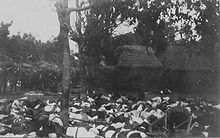History of Bali
The History of Bali covers a period from the Paleolithic to the present, and is characterized by migrations of people and cultures from other parts of Asia.
In the 16th century, the history of Bali started to be marked by Western influence with the arrival of Europeans, to become, after a long and difficult colonial period under the Dutch, an example of the preservation of traditional cultures and a key tourist destination.
The tertiary ocean floor, made of ancient marine deposits including accumulation of coral reefs, was lifted above the sea level by the subduction.
[1] The local deformation of the Eurasian plate created by the subduction has encouraged the fissuring of the crust, leading to the arising of volcanic phenomena.
[1] Volcanic activity, due to the thick deposits of ashes and the soil fertility it generates, has also been a strong factor in the agricultural prosperity of the island.
[7] From around 3000 to 600 BCE, a Neolithic culture emerges, characterized by a new wave of inhabitants bringing rice-growing technology and speaking Austronesian languages.
Between the 8th and 3rd century BCE, the island of Bali acquired the "Dong Son" metallurgical techniques spreading from Northern Vietnam.
[4] The ancient historical period is defined by the appearance of the first written records in Bali, in the form of clay pallets with Buddhist inscriptions.
The Belanjong pillar ("Prasasti Blanjong") in southern Sanur was inscribed in 914 with the mention of the reign of the Balinese king Sri Kesari.
[13] The island of Java again started to encroach significantly on Bali with the invasion of the Singhasari king Kertanegara in 1284, as reported in the Nagarakertagama (canto 42, stanza 1).
[14] With the rise of Islam in the Indonesian archipelago, the Majapahit empire finally fell, and Bali became independent at the end of the 15th or beginning of the 16th century.
In the 16th century, the Balinese king Dalem Baturenggong even expanded in turn his rule to East Java, Lombok and western Sumbawa.
[14] Around 1540, together with the Islamic advance, a Hindu reformation movement took place, led by Dang Hyang Nirartha, leading to the introduction of the Padmasana shrine in honour of the "Supreme God" Acintya,[15] and the establishment of the present shape of Shiva-worshipping in Bali.
The first known European contact with Bali is thought to have been made in 1512, when a Portuguese expedition led by António de Abreu and Francisco Serrão reached its northern coast.
The opening of a trading post was attempted in 1620, with the mission given to the First Merchant Hans van Meldert to purchase "rice, beasts, provisions, and women".
The island was in fact split in nine minor kingdoms (Klungkung, Buleleng, Karangasem, Mengwi, Badung, Tabanan, Gianyar, Bangli, Jembrana).
Napoleon handpicked a new Governor-General, the "Iron Marshall" Willem Daendels, sent ships and troops to reinforce the East Indies against British attacks, and had military fortifications built through the length of Java.
A treaty of alliance was signed in 1808 between the new administration and the Balinese king of Badung, to provide workers and soldiers for the Franco-Dutch defensive effort, but Java fell to the British in 1811, and the agreement was not implemented.
Raffles' abolition of slavery on the contrary triggered the indignation of the Rajas of Buleleng and Karangasem, who sent a military expedition against Blambangan, where they fought British Sepoys in February 1814.
In Bali, the Dutch used the pretext of eradicating opium smuggling, arms running, plunder of shipwrecks, and slavery to impose their control on Balinese kingdoms.
[33] The king of Buleleng and his retinue killed themselves in a mass ritual suicide, called a puputan, which was also a hallmark of the subsequent Dutch military interventions.
Initially unsuccessful, the expedition was reinforced by 700 men and a new commander, Colonel de Brabant, and prevailed with only two officers and 10 soldiers killed.
The Dutch military interventions however were followed closely by the western press which supplied a steady stream of reports of the violent, bloody conquest of the southern part of the island.
As a consequence, the Dutch in Bali turned students and protectors of Balinese culture and endeavoured to preserve it in addition to their initial modernisation role.
Sukarno famously said: "The Lord be praised, God showed me the way; in that valley of the Ngarai I said: Yes, Independent Indonesia can only be achieved with Dai Nippon...For the first time in all my life, I saw myself in the mirror of Asia".
The following month Bali was liberated by the British and Indian 5th infantry Division under the command of Major-General Robert Mansergh who took the Japanese surrender.
Colonel I Gusti Ngurah Rai, by then 29 years old, rallied his forces in east Bali at Marga Rana, where they were trapped by heavily armed Dutch troops.
[49] The 1963 eruption of Mount Agung killed thousands, created economic havoc and forced many displaced Balinese to be transmigrated to different parts of Indonesia.
The pre-War Bali as "paradise" was revived in a modern form, and the resulting large growth in tourism has led to a dramatic increase in Balinese standards of living and significant foreign exchange earned for the country.
[51][53] Political trouble has also affected the island, as the bombing in 2002 by militant Islamists in the tourist area of Kuta killed 202 people, mostly foreigners.














